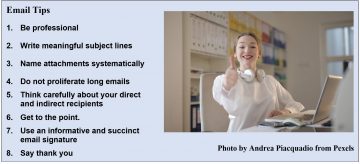
 By Dr. Michael Hughes, Research Associate & Diana Canals, PhD Student, McNagny Lab
By Dr. Michael Hughes, Research Associate & Diana Canals, PhD Student, McNagny Lab
You suck at email!
Sorry to be so blunt, but if you have been in academia even if only for a little while, chances are you have seen (or even adopted) some bad email habits. We bet your supervisor is probably even worse. One consequence of the COVID-19 pandemic is the need to work from home and communicate remotely. Although many of us have always relied on email to communicate with colleagues, it is now more important than ever to practice good habits in your email correspondence. A bit of effort in crafting an effective email will save you and your recipients some frustration.
After learning the hard way, we have compiled a few tips to help with remote scientific communication. These are a cure for frustration – pandemic or no pandemic.

Photo by Andrea Piacquadio from Pexels
1. Be professional.
It probably goes without saying: your emails should be professional. Emails may seem fleeting, but they are long-lasting or even permanent records that reflect on your professionalism. This does not necessarily mean they have to be formal, but you should be aware of your audience. Use your correspondence to inform and communicate. Here are a few (hopefully obvious) points for professionalism using email and communication in general:
- Don’t email when you’re angry or frustrated. Take a few hours (or days) to cool off and consider your objectives. A quick-draw, shoot-from-the-hip rebuttal email may make you feel better (temporarily) but will almost certainly make things worse.
- Don’t use email to passively burn or shame colleagues. The “cc attack” and “reply all slam” might feel righteous but will often backfire.
- Direct and blunt is ok, but don’t be rude, as it may be counterproductive.
- Proofread for spelling and grammar. Perfection is not required, but make sure the reader is able to understand your meaning.
2. Write meaningful subject lines.
I’m sure everyone’s INBOX is stuffed under the research curtailment conditions. It is hard to keep up. Ever tried to search for an email in your inbox only to find that the subject line and email content have no helpful keywords? It’s impossible!
Examples of BAD subject lines:
- Dude!!!!
- grant….&*#$%#^&
- urgent
- (leaving the subject line blank)
Examples of GOOD (useful) subject lines:
- Follow up on our conversation about (content)
- Results from experiment (brief description)
- Reviewed draft of (content) manuscript (version #)
Make sure your subject lines have at least one keyword that can be linked to the content of your email – especially if it includes attachments.
And very, very importantly…DO NOT WRITE THE WHOLE CONTENT OF THE EMAIL IN THE SUBJECT LINE (especially in all caps).
3. Name attachments systematically.
Yes, attachments are necessary in our work. But name your attached files systematically so people can find them again in their inbox or when they download the documents to their computers.
Bad attachment name: New Draft
Good attachment name: CIHR Spring 2020 Grant Draft Jan 23_(initials) edits
4. Do not proliferate long email strings.
Limit yourself to one reply if you can manage. Start a new email thread if the conversation evolves and goes beyond a couple of exchanges. It is a good idea to change the subject in the reply – particularly if it wasn’t a good subject line in the first place. This is particularly important if there are several people on the recipient list as long email strings are cumbersome and inefficient. Important information can easily get buried in a long string and recipients are burdened to hunt through the text to find the salient points.
When starting a new thread, it is also important to revise the recipient list – Are all the original recipients still involved in this conversation or has the discussion been reduced to 2-3 recipients tasked with action items? Move non-essential recipients to the cc list if you no longer need (or expect) continued input.

5. Think carefully about your direct (to:) and indirect (cc:) recipients.
Think about who actually needs to respond to your email. If you want an individual (or individuals) to respond to your email, make sure you address them directly in the email and send it to them directly (to:). People receive too many emails to be able to respond to all the correspondence in their INBOX, especially if they are NOT the primary recipient. If you place a recipient in the cc list, consider this a signal that this email is for their interest and you are NOT expecting a direct reply. If you desire a direct reply – send a direct email.
6. Get to the point.
A polite opening salutation is good, especially for acquaintances. Introduce yourself if this is a first interaction but, either way, make sure you get to the point as soon as possible. The rationale of your request can come later, but don’t make the recipient wait until the end of your email to know what you are asking of them (if anything). If the rationale is complicated, arrange a telephone call. Not every remote meeting needs to be a ZOOM meeting! Video call if you need to show figures or slides or need more than 3 participants.
Clearly state what you’re asking the recipient to do. If the recipient doesn’t know you want a response, they may not give you one. Ask for what you want directly, underline, use bold type face, or provide a list with bullet points for the important action items or deadlines.
7. Use an informative and succinct email signature.
For more formal emails, use an email signature that includes your mailing address, email address and phone number. Your title and other contact information are optional but probably a good idea for virtual introductions. Twitter, LinkedIn, ResearchGate and other professional social media links are ok if not obtrusive. For less-formal, routine internal (i.e., intra-lab) messages, use an abbreviated signature with just your name, email address and phone number. Please remember – your email signature is not a CV, promotional advertisement or an editorial opinion page.
8. Say thank you.
Remember to say thank you to the recipient, especially if you are asking them to take a specific action. It’s always appreciated. Working at home is stressful for most people accustomed to an interactive lab and office environment. Email correspondence should be efficient but don’t forget that you are talking to another person dealing with the same stresses you may be experiencing.
The amount of emails we receive might be at times overwhelming. However, if you follow these simple tips, who knows, your recipients might even read your whole email!


